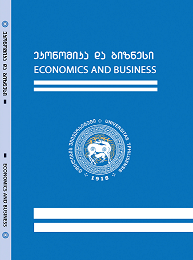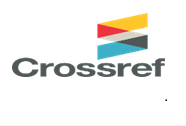
Referential and Reviewed International Scientific-Analytical Journal of Ivane Javakhishvili Tbilisi State University, Faculty of Economics and Business

The Impact of Social Media Marketing Activities on Purchase Intentions of Healthcare Consumers
According to this study, social networks have become an essential part of the lives of Georgian consumers, and they use them frequently. Georgian consumers are increasingly using the Internet to obtain medical treatment and are especially interested in information linked to health. Nevertheless, it should be noted that COVID-19 has significantly altered its perspective on social media. As a result, individuals started to show greater interest in the details and deals offered by healthcare providers. Healthcare providers operating in Georgia's medical services industry have official social media profiles. Our research indicates that Georgian consumers demonstrate a reasonably low activity level. In addition, Georgian consumers do not trust the content shared on social media. Regression analysis revealed statistically significant values that show how customer engagement, trust, and behavioural intentions relate to social media activities offered by healthcare organizations. Additionally, linear regression models that account for the connections between the abovementioned variables are received. Using these models, we can determine how increased social media advertising activities may impact consumer behaviour.
Based on the study results, we considered it appropriate to make some recommendations.
- To make social media marketing more popular in the healthcare field in Georgia, it is necessary to hold various events. Healthcare organizations need to realize that more integration in social media is a way to attract consumers to the market and gain a competitive advantage rather than incur extra costs. For this, healthcare organizations should be supported by relevant government structures and organize multilateral meetings to promote social media marketing. For example, it is possible to launch various social campaigns related to healthcare, the target audience of which will be mainly social media users.
- Healthcare organizations must become more active on social media platforms and conduct direct, personal messaging-based communication with consumers. It is advisable for all medical institutions to have a social media service and to invest more resources in its activities. Representatives of such a service should improve their image and reach out directly to customers.
- As the culture of self-health monitoring by the population in Georgia is low, social media can be an ideal place to disseminate this kind of information. This will have a double effect. One is that the number of users of the medical institution will increase, and the other is that the level of health self-control by the population of Georgia will also increase. Social media should provide users with health-related tips that will be interesting, authentic, and helpful. We consider it reasonable to create special groups, which will be staffed by doctors, designers, marketers, and social media specialists. Physicians must ensure the preparation of the textual part of the content, and the designer must create visual content that will be consistent with the content of the text. The marketer must provide the designer with the material for the design. All of this should be coordinated by a social media specialist who will eventually place the content on social media platforms and ensure its management. This is an excellent opportunity for the medical facility to set up an appropriate platform and consult patients remotely. Of course, gaining consumers' trust in the first stage will be challenging, but gradually, as the number of patients increases, the degree of confidence will also increase.
- Georgian consumers are not accustomed to writing reviews about the quality of medical services on social media. In many countries, having evaluations is very important for medical institutions. They do their best to avoid negative evaluations. It is a system through which the user forces the medical institution to improve the quality. As a result, the quality of medical services increases, which positively impacts both parties, clinics and customers.
The usage of social media marketing in the healthcare industry is affected by this research in several theoretical ways. First of all, it is essential to recognize that even though social media marketing activities are a very broad issue and have been the subject of much research, there still needs to be more in this field. This means theorems research needs to be done to establish a connection between medical organizations' social media marketing activities and variables such as customer engagement, trust, and behavioural intention that impact consumer behaviour. The relationship between these variables is established in part by this study. However, we discovered that the social media marketing activity factors we chose based on the research were significant and relevant to the healthcare sector. The study acknowledges the significance of social media marketing initiatives to guarantee the growth of consumer behaviour in the medical services market, which enhances the amount of information already known in this area. In conclusion, this study provided a multitude of data that may be applied in further investigations to acquire a more profound understanding of the influence of social media marketing on customer behaviour.
From the managerial perspective, this study's primary contributions are as follows: First, managers working in the health industry will benefit from the study's findings as they expand their knowledge of how social media marketing initiatives may be useful tools for connecting with current and prospective customers. Secondly, companies in the health industry might use the research results to inform their business plan preparation. Third, by better understanding their consumers' purchasing perceptions, healthcare providers will be able to create marketing strategies that will assist them in reaching their objectives.
References:
Abid A., Roy S. K., Lees-Marshment, J., Dey B. L., Muhammad S. S. & Kumar S. (2023). Political Social Media Marketing: A Systematic literature Review and Agenda for Future Research. Electronic Commerce Research, 1-36.
Anderson S.T., Nasr L. & Rayburn S.W. (2018). Transformative Service Research and Service Design: Synergistic Effects in Healthcare. Service Industries Journal, 38(1-2), 99-113.
Baabdullah A. M., Alalwan A. A., Rana N. P., Kizgin H. & Patil P. (2019). Consumer Use of Mobile Banking (M-Banking) in Saudi Arabia: Towards an Integrated Model. International Journal of Information Management, 44, 38-52.
Brodie R. J., Ilic A., Juric B. & Hollebeek L. (2013). Consumer Engagement in a Virtual Brand Community: An Exploratory Analysis. Journal of business research, 66(1), 105-114.
Bryman A., & Bell E. (2011). Business Research Methods. 3rd Edition. New York: Oxford University Press.
Carlsson-Szlezak P., Reeves M., & Swartz P. (2020). What Coronavirus Could Mean for the Global Economy. Harvard Business Review, 3.
Ceglarz A., Beneking A., Ellenbeck S., & Battaglini A. (2017). Understanding the Role of Trust in Power Line Development Projects: Evidence from Two Case Studies in Norway. Energy Policy, 110, 570-580.
Chaves Prasetya T. A. E. & Wardani R. W. K. (2023). Systematic Review of Social Media Addiction Among Health Workers During the Pandemic Covid-19. Heliyon, 9(6), e16784.
Chen Y.Y., Li C.M., Liang J.C. & Tsai C.C. (2018). Health Information Obtained From the Internet and Changes in Medical Decision Making: Questionnaire Development and Cross-Sectional Survey. Journal of Medical Internet Research, 20(2), e47.
Chiu C. M., Hsu M. H., Lai H. & Chang C. M. (2012). Re-Examining the Influence of Trust on Online Repeat Purchase Intention: The Moderating Role of Habit and its Antecedents. Decision Support Systems, 53(4), 835-845.
Colicev A., Malshe A., Pauwels K. & O’Connor P. (2018). Improving Consumer Mindset Metrics and Shareholder Value Through Social Media: the Different Roles of Owned and Earned Media, Journal of Marketing, 82(1), 37-56.
Dodokh A., & Al-Maaitah M. A. (2019). Impact of Social Media Usage on Organizational Performance in the Jordanian Dead Sea Cosmetic Sector. European Journal of Business and Management, 11(2), 75-91.
Dolan R., Conduit J., Fahy J. & Goodman S. (2016). Social Media Engagement Behaviour: a Uses and Gratications Perspective, Journal of Strategic Marketing, 24(3-4), 261-277.
Farsi D. J. (2021). Social Media and Health Care, Part I: Literature Review of Social Media Use by Health Care Providers. Journal of Medical Internet Research, 23(4), e23205.
Freire Y., Sánchez M. G., SuÁrez A., Joves G., Nowak M. & Díaz-Flores García V. (2023). Influence of the Use of Social Media on Patients Changing Dental Practice: a Web-Based Questionnaire Study. BMC Oral Health, 23(1), 365.
Ghalavand H., Panahi S. & Sedghi S. (2020). Opportunities and Challenges of Social Media for Health Knowledge Management: A Narrative Review. Journal of Education and Health Promotion, 9, 1-5.
Hajli N., Sims J., Zadeh A. H., & Richard M. O. (2017). A Social Commerce Investigation of the Role of Trust in a Social Networking Site on Purchase Intentions. Journal of Business Research, 71, 133-141.
Harmeling C.M., Moffett J.W., Arnold, M.J. & Carlson B. D. (2017). Toward a Theory of Customer Engagement Marketing. Journal of the Academy of Marketing Science, 45(3), 312-335.
Hawkins J. B., Brownstein J. S., Tuli G., Runels T., Broecker K., Nsoesie E. O. & Greaves F. (2016). Measuring Patient-Perceived Quality of Care in US Hospitals Using Twitter. BMJ quality & safety, 25(6), 404-413.
Healthcare and Social Issues Committee of the Parliament of Georgia. (2017). Vision for Developing the Healthcare System in Georgia by 2030. Tbilisi, Parliament of Georgia. Retrieved December 20, 2023, from http://www.parliament.ge/ge/ajax/downloadFile/81366/Health_Strategy_Eng
Hollebeek L. D., Glynn M. S. & Brodie R. J. (2014). Consumer Brand Engagement in Social Media: Conceptualization, Scale Development and Validation. Journal of Interactive Marketing, 28(2), 149-165.
Hollebeek L. D., Srivastava R. K. & Chen T. (2019). SD Logic–Informed Customer Engagement: Integrative Framework, Revised Fundamental Propositions, and Application to CRM. Journal of the Academy of Marketing Science, 47(1), 161-185.
Hong I. B., & Cha H. S. (2013). The Mediating Role of Consumer Trust in an Online Merchant in Predicting Purchase Intention. International Journal of Information Management, 33(6), 927-939.
Hung C. L., Wu J. H., Chen P. Y., Xu X., Hsu W. L., Lin L. M. & Hsieh M. C. (2023). Enhancing Healthcare Services and Brand Engagement Through Social Media Marketing: Integration of Kotler's 5A Framework with IDEA Process. Information Processing & Management, 60(4), 103379.
Huppertz J. W. & Otto P. (2018). Predicting HCAHPS Scores from Hospitals’ Social Media Pages: A Sentiment Analysis. Health care management review, 43(4), 359-367.
Hutter K., Hautz J., Dennhardt S. & Füller J. (2013). The Impact of User Interactions in Social Media on Brand Awareness and Purchase Intention: the Case of MINI on Facebook. Journal of Product & Brand Management, 22 (5-6), 342-351.
Jackson M., Brennan L. & Parker L. (2021). The Public Health Community's Use of Social Media for Policy Advocacy: a Scoping Review and Suggestions to Advance the Field. Public Health, 198, 146-155.
Kamarudin Y., Low, D. F. F. Sulaiman A., Zulhusmi A. M. & Zakaria N. N. (2022). Social Media Use and Marketing within the Orthodontic Practice in Malaysia. Archives of Orofacial Science, 17(1).87-100.
Khan I., Saleh M. A., Quazi, A. & Johns R. (2021). Health Consumers’ Social Media Adoption Behaviours in Australia. Health Informatics Journal, 27(2), 14604582211009917.
Kostygina G., Tran H., Binns S., Szczypka G., Emery S., Vallone D. & Hair E. (2020). Boosting Health Campaign Reach and Engagement Through Use of Social Media Influencers and Memes. Social Media+ Society, 6(2), 1-12.
Krejcie R. V. & Morgan D. W. (1970). Determining Sample Size for Research Activities. Educational and Psychological Measurement, 30(3), 607-610.
Kumar V. & Pansari A. (2016). Competitive Advantage Through Engagement. Journal of Marketing Research, 53(4), 497-514.
Kwortnik Jr, R. J. & Han X. (2011). The Influence of Guest Perceptions of Service Fairness on Lodging Loyalty in China. Cornell Hospitality Quarterly, 52(3), 321-332.
Li Y., Wang X., Lin X. & Hajli, M. (2018). Seeking and Sharing Health Information on Social Media: A Net Valence Model and Cross-Cultural Comparison. Technological Forecasting and Social Change, 126, 28–40.
Malhotra N. (2010). Marketing Research: An Applied Orientation. 6th ed., Upper Saddle River N.J.; London: Pearson Education.
Manzoor U., Baig S. A., Hashim M. & Sami A. (2020). Impact of Social Media Marketing on Consumer’s Purchase Intentions: the Mediating Role of Customer Trust. International Journal of Entrepreneurial Research, 3(2), 41-48.
Manzoor U., Baig S. A., Hashim M. & Sami A. (2020). Impact of Social Media Marketing on Consumer’s Purchase Intentions: the Mediating Role of Customer Trust. International Journal of Entrepreneurial Research, 3(2), 41-48.
Mladenovie D., Todua N. & Pavlovie-HSck N. (2023). Understanding Individual Psychological and Behavioral Responses During COVID-19: Application of Stimulus-Organism-Response Model. Telematics and Informatics, 79, 101966.
Mondal T., Jayadeva S. M., Pani R., Subramanian M., & Sumana B. (2022). E Marketing Strategy in Health Care Using IoT and Machine Learning. Materials Today: Proceedings, 56, 2087-2091.
National Statistics Office of Georgia. (2023). Retrieved December 20, 2023, from https://www.geostat.ge/en
Nunnally J.C. (1967). Psychometric Theory. New York, NY: McGraw-Hill Book Company.
Oosthuizen D., Spowart J. & De Meyer-Heydenrych C. F. (2015). The Relationship Between Perceived Price and Consumers’ Purchase Intentions of Private Label Wine Brands. African Journal of Hospitality, Tourism and Leisure, 4(2), 1-17.
Pansari A., & Kumar, V. (2017). Customer Engagement: the Construct, Antecedents, and Consequences. Journal of the Academy of Marketing Science, 45(3), 294-311.
Pilon L., Foster A., Zimmerman P. A., & Macbeth D. (2023). The Role of Online Marketing to Engage Healthcare Workers with Infection Prevention and Control Information and Resources: A Pilot Study. Infection, Disease & Health, 28.
Pirson M., Martin K. & Parmar B. (2017). Formation of Stakeholder Trust in Business and the Role of Personal Values. Journal of Business Ethics, 145(1), 1-20.
Prasetya T. A. E. & Wardani R. W. K. (2023). Systematic Review of Social Media Addiction Among Health Workers During the Pandemic Covid-19. Heliyon, 9(6), e16784.
Rahman Z. (2017). The Impact of Social Media Engagement Metrics on Purchase Intention: A Study on Brand Fan Page Followers. LUMEN Proceedings, 1, 665-681.
Renu N. (2021). Innovative Healthcare Marketing Strategies during COVID-19. Journal of Marketing Management, 9(2), 45-49.
Rezvani S., Dehkordi G. J., Rahman M. S., Fouladivanda F., Habibi, M. & Eghtebasi S. (2012). A Conceptual Study on the Country of Origin Effect on Consumer Purchase Intention. Asian Social Science, 8(12), 205-215.
Saunders M., Lewis P. & Thornhill A. (2019). Research Methods for Business Students. 8th ed., Harlow: Pearson Education Ltd.
Schivinski B., Christodoulides G. & Dabrowski D. (2016). Measuring Consumers' Engagement with Brand-Related Social Media Content: Development and Validation of a Scale that Identifies levels of Social Media Engagement with Brands. Journal of Advertising Research, 56(1), 64-80.
Swan E.L., Dahl A.J. & Peltier J.W. (2019). Health-Care Marketing in an Omni-Channel Environment: Exploring Telemedicine and Other Digital Touchpoints. Journal of Research in Interactive Marketing, 13(4), 602-618.
Todua N. & Jashi Ch. (2018). Influence of Social Marketing on the Behavior of Georgian Consumers Regarding Healthy Nutrition. Bulletin of the Georgian National Academy of Sciences, 12(2), 183-190.
Toor A., Husnain M., & Hussain T. (2017). The Impact of Social Network Marketing on Consumer Purchase Intention in Pakistan: Consumer Engagement as a Mediator. AJBA, 10(1), 167-199.
Viswanathan V., Malthouse E. C., Maslowska E., Hoornaert S. & Van den Poel D. (2018). Dynamics Between Social Media Engagement, Firm-Generated Content, and live and Time-Shifted TV Viewing. Journal of Service Management, 29(3), 378–398.
Wang J. C., & Chang C. H. (2013). How Online Social Ties and Product-Related Risks Influence Purchase Intentions: A Facebook Experiment. Electronic Commerce Research and Applications, 12(5), 337-346.
Wang S. S. & Stefanone M. A. (2013). Showing Off? Human Mobility and the Interplay of Traits, Self-disclosure, and Facebook Check-Ins. Social Science Computer Review, 31(4), 437-457.
Wang Z. & Kim H. G. (2017). Can Social Media Marketing Improve Customer Relationship Capabilities and Firm Performance? Dynamic Capability Perspective. Journal of Interactive Marketing, 39, 15-26.
World Health Organization. Regional Office for Europe, European Observatory on Health Systems and Policies, Richardson E. & Berdzuli, N. (2017). Georgia: health System Review. World Health Organization. Regional Office for Europe. Retrieved December 20, 2023, from https://apps.who.int/iris/handle/10665/330206
Yadav M. & Rahman Z. (2017). Measuring Consumer Perception of Social Media Marketing Activities in E-commerce Industry: Scale development & validation. Telematics and Informatics, 34(7), 1294-1307.
Zhou L., Zhang D., Yang C. C. & Wang Y. (2018). Harnessing Social Media for Health Information Management. Electronic Commerce Research and Applications, 27, 139–151.
Keywords: Social Media, Health Care, Consumer Behavior, Marketing Research.
JEL Codes: I10, I11, D11, M31









